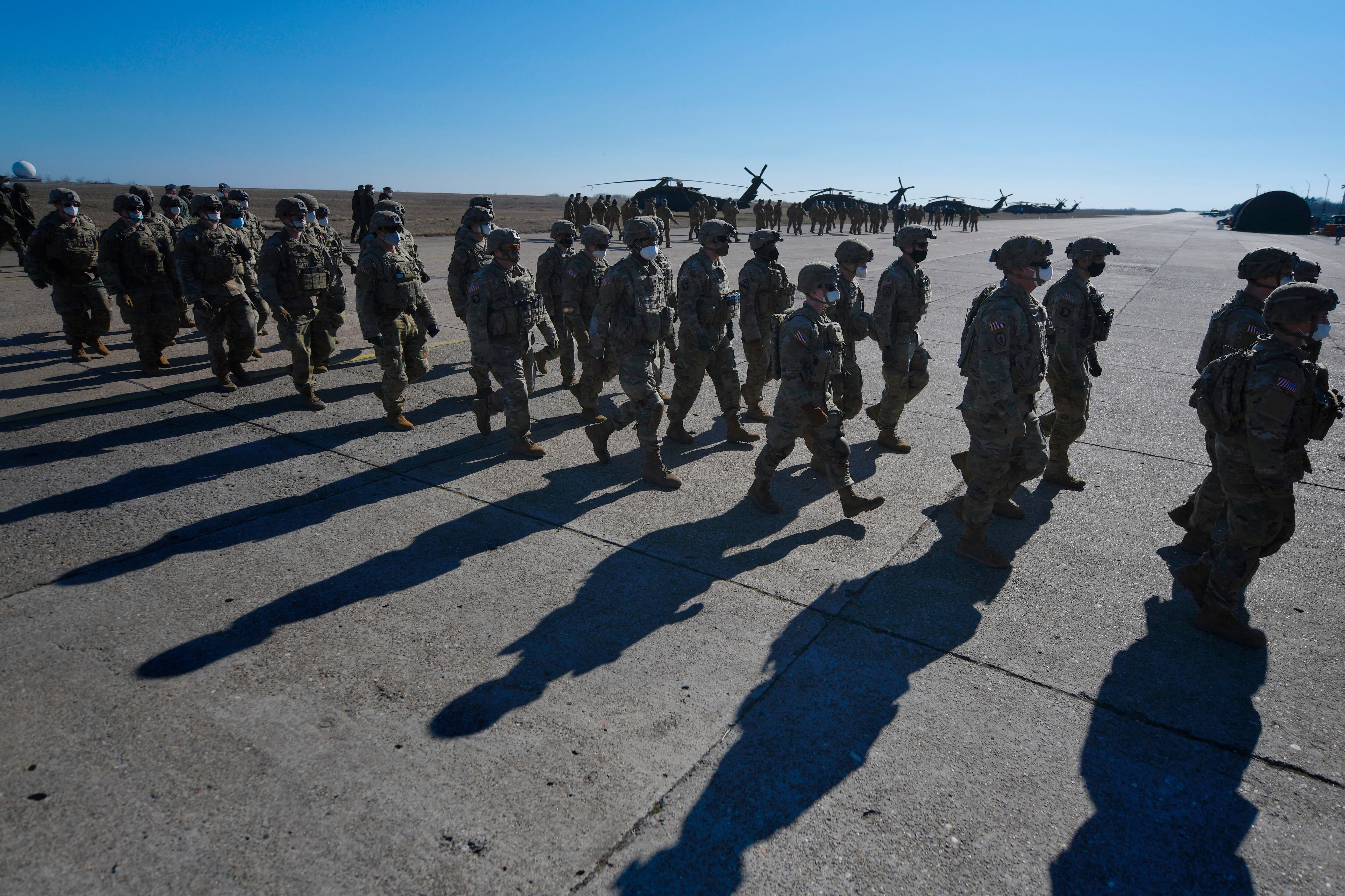WASHINGTON ― The Pentagon is considering whether to add U.S. troops in Eastern European NATO-member countries on a long-term basis in the wake of Russia’s invasion of Ukraine, a senior Pentagon official told lawmakers Tuesday.
The Biden administration’s $6.4 billion request to Congress to respond to the Ukraine crisis includes $3.5 billion for the Pentagon, to pay for operating costs associated with the surge to the current 100,000 U.S. troops in Europe or its waters and also to backfill weapons the U.S. military is sending from its stockpiles to Ukraine.
Assistant Defense Secretary for Strategy, Plans and Capabilities Mara Karlin told the House Armed Services Committee that the Pentagon would be re-examining the Global Posture Review, Defense Secretary Lloyd Austin’s most recent troop allocation plan.
“We recognize this dynamic situation now requires us to give it another fine-tooth look, to see what’s necessary to ensure that we’ve got deterrence of Russia and that we can absolutely 150% say that NATO is safe and secure,” Karlin said.
“So we’re looking at what sort of troop presence – whether it’s rotational or permanent – is necessary given this current security environment, both in the near term and frankly, and in the long term.”
The comment was in response to HASC’s top Republican, Rep. Mike Rogers, who said that prior to Russia’s invasion there was talk of permanently-stationed U.S. troops in Romania, and the Baltic countries. “Does the administration support this result that after this invasion, that we make that troop presence permanent in those Eastern European front countries,” Rogers asked.
Earlier this month, Rogers and Rep. Mike Turner, who is the top Republican on the House Intelligence Committee, sent a letter to Romanian President Klaus Iohannis encouraging the U.S. and Romanian governments to explore ways to create a permanent joint military base in Romania.
RELATED

Eastern European NATO members have long sought heftier troop commitments from major alliance members to signal deterrence to Russia. There are already battlegroups in the three Baltic states, provided by European and Canadian forces, and Poland hosts a similar contingent under U.S. leadership. France announced last week it would send a new formation to Romania, comprised of 500 personnel and armored vehicles.
Estonian Prime Minister Kaja Kallas on Tuesday urged NATO to do more for the Baltics. Speaking alongside British Prime Minister Boris Johnson and NATO Secretary-General Jens Stoltenberg at Tapa military base in Estonia, she said the three small countries need better defense capabilities on land and in the air. The alliance should “move from air policing to air defense,” she said.
The Pentagon has in recent days mobilized some 14,000 of troops, along with F-35 strike fighters and Apache helicopters to Poland, Hungary and the Baltics. The U.S. troop presence had surged from 80,000, an uptick that U.S. President Joe Biden has stressed is meant to reinforce allies and not for getting involved in Russia’s war on Ukraine.
U.S. materiel pledged to Ukraine since September has included Stinger anti-aircraft missiles, Javelin anti-tank missiles, grenade launchers, and more than 2,000 tons of ammunition including mortar and artillery rounds, small arms and machine guns, Karlin said.
In the last six months, Biden has authorized three tranches of aid under his drawdown authority, which included equipment from U.S. stockpiles, including a package worth $350 million last week. The U.S. has committed $1 billion in security assistance to Ukraine over the last year.
Rogers criticized the administration for moving too cautiously on the aid as Russian troops amassed on Ukraine’s borders. He urged that NATO allies receive the surface-to-surface Army Tactical Missile System and High Mobility Artillery Rocket System.
“It is now more important than ever to reinforce our NATO allies, especially those on the Eastern front,” Rogers said. Romania, Poland and the Baltic states need advanced integrated air defense assets, missile systems like HIMARS and ATACMS – and enhanced permanent U.S. troop presence – and they need it yesterday.”
Pressure on the administration came from both sides of the aisle. Emphasizing the unique level of bipartisan support for Ukraine and urgency of its fight, Michigan Democratic Rep. Elissa Slotkin pressed for the administration to be more forthcoming about its needs.
“I would just say you have an absolutely unique moment where the U.S. Congress has bipartisan agreement on giving you what you need, and we’re not getting an ask,” said Slotkin, who is a former Pentagon official. “Ask us for things and we will help you.”
Congress’s Democratic leaders have signaled that an omnibus funding bill for fiscal 2023, already five months overdue and needed to fund the U.S. federal government by March 11, will have to either take precedence or include the administration’s request for Ukraine aid.
Rep. Doug Lamborn, R-Colo., was among some of the Republicans who have pushed back in favor of immediate action, urging the White House to “get our leadership off the dime.”
“They’re doing nothing here in the House,” Lamborn said. “We could be sending this money to Ukraine, and people are literally dying and will die in the next week, needlessly.”
HASC Chairman Rep. Adam Smith, D-Wash., argued that while the House was taking time to get the legislation right, Biden was taking executive action to send Ukraine weapons and humanitarian aid.
“There is a ton of money that is flowing out of the United States of America right now to help the people of Ukraine,” Smith said, adding: “If nothing was happening, then I would be right there with you, saying we got to pass this yesterday.”
Joe Gould was the senior Pentagon reporter for Defense News, covering the intersection of national security policy, politics and the defense industry. He had previously served as Congress reporter.




